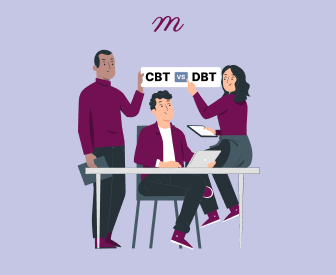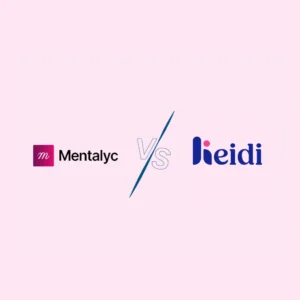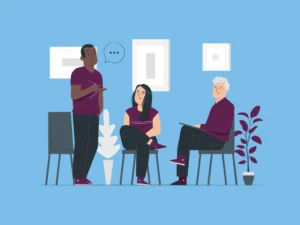Cognitive Behavioral Therapy (CBT) and Dialectical Behavioral Therapy (DBT) are two popular types of psychotherapy. They help individuals going through mental health challenges live healthier and more balanced lives. However, they have different treatment approaches.
CBT works by helping people deal with unhelpful thought patterns and behaviors. DBT, on the other hand, focuses on managing people’s strong emotions and enhances their relationship with others.
In this post, you’ll learn how these therapies work, along with their techniques and how they improve mental health. It is important for mental health professionals to understand the differences between CBT and DBT. This knowledge will assist you in choosing the best type of treatment for each of your client’s unique needs.
What is Cognitive Behavioral Therapy (CBT)?
CBT is a type of psychotherapy that has been proven to treat a wide range of mental health conditions. These conditions include anxiety disorders, depression, and obsessive-compulsive disorder (OCD). It helps individuals recognize how distorted thought patterns affect their emotions and behaviors. CBT empowers such individuals to challenge and change these negative thoughts. When people are able to identify these negative patterns then, they can change them for healthier ones.
For example, a person who thinks he is not good enough or sees himself as a failure will keep engaging in habits that reinforce those thoughts. With cognitive behavioral therapy, such an individual can deal with such negative thoughts.
CBT has also been shown to be effective for treating other issues like chronic pain, insomnia, and addiction.
Aaron Beck introduced Cognitive Behavioral Therapy (CBT) in the 1960s. Over time, it evolved to include new techniques that help people identify and change negative thought patterns. Today, CBT is widely regarded as one of the most effective treatments for a variety of mental health issues. Research shows that CBT is more effective than other types of psychotherapy.
During CBT sessions, clients are actively engaged in tasks, such as journaling or writing about their thoughts and feelings. For example, in my sessions with clients diagnosed with substance use disorder, I often assign take-home activities. These might include listing the negative effects of substances or identifying personal triggers like people, places, things and situations that lead to substance use.
These practical assignments make CBT highly effective by teaching individuals new, healthier ways to cope with their mental health challenges.
The following are common cognitive behavioral therapy techniques:
Cognitive Restructuring
This technique helps individuals identify and correct flawed thinking patterns. It allows them to shift from negative thoughts to more balanced ones.
For Example – Instead of thinking, “I’m a failure,” an individual could say, “I struggle with this, but I’ve succeeded in other areas.”
Behavioral Activation
This technique encourages individuals to engage in activities they find pleasure in doing. It helps them deal with low motivation and the feelings of sadness that come from negative thoughts.
For Example – You used to enjoy playing the guitar as it made you happy. This technique will help you go back to playing guitar to improve your mood. This will in turn have a positive influence on your thoughts and behaviors.
Exposure Techniques
This is a CBT method to help people face and overcome their fear in a controlled environment. Some therapists might engage in graded exposure, image-based exposure, interoceptive exposure or systematic desensitization. They are commonly used in treating panic or anxiety disorders.
For example, a client used to be anxious about speaking in public. But after exposure to a few people in a controlled setting, the fear of public speaking significantly reduced.
Cognitive Reframing
This technique helps individuals view situations differently. It enables them to see the positive side of a challenging situation.
For Example – Instead of saying, “I failed to pass this driving test,” an individual might say, “I will get a driving instructor and learn how to parallel park better.”
Thought Records
This tool is very effective in helping people catch and note down their thoughts and feelings. It allows them to challenge the negative thoughts that pop up automatically or intrusively. Then those irrational thoughts can be replaced with healthier ones.
For Instance, an individual can write down the negative thoughts to check if they are rational and accurate. This will help to promote change or cause a shift in thinking if the thoughts are irrational.
Relaxation Techniques
When a client experiences stress and gets anxious, this technique provides a sense of calm.
For Example – Your client can practice the 4-7-8 deep breathing exercise to help calm the mind and body.
CBT treatment aims to help change the thinking and behavioral patterns of individuals. There are other techniques to achieve this purpose. They include:
Mindfulness-Based CBT
This involves relaxing your body and quieting your thoughts. With this technique an individual can focus on the present moment without feeling judged. Most times, it will help make the individual feel less anxious and allows for progress during therapy.
Cognitive Behavioral Rehearsal
This technique helps an individual prepare for real life situations by practicing for them in a safe environment.
Role Playing
This allows a person to prepare for social situations in a supportive setting and reflect on what could go wrong.
Problem Solving
It involves learning to use problem-solving techniques to handle challenging situations.
Successive Approximation
This technique involves breaking down goals into small steps. For instance, when you feel overwhelmed by a project, you can break it into smaller tasks. Think of ways to solve the problem and pick the ones that seem doable first. It builds your confidence and helps to ease you into the project as you gradually face the harder tasks. You will also feel a sense of accomplishment as you successfully finish each task.
Socratic Questioning
This approach is very reflective as it enables individuals to think more critically about their situation. It encourages deeper understanding of their thoughts.
CBT treatment applies to individuals with the following mental health conditions:
- Depression
- Anxiety
- Obsessive-Compulsive Disorder
- Post-traumatic Stress Disorder
- Attention Deficit Hyperactivity Disorder (ADHD)
- Bipolar Disorder
CBT is generally not used for clients with antisocial personality disorder or certain amnesia conditions. Individuals with antisocial personality disorder often struggle to understand their actions and may not feel the need to change. For those with amnesia, CBT may not be effective because their memory issues can make it difficult to engage in the therapy. Instead, medical support is often needed to address these conditions. This could include medication to help manage symptoms or cognitive rehabilitation to improve memory and understanding.
For cases of severe depression, research shows that CBT can be more effective when incorporated with medication.
What is Dialectical Behavioral Therapy (DBT)?
DBT is a type of psychotherapy used to treat individuals who find it hard to manage their emotions. It mainly helps people handle overwhelming feelings that can create problems in their relationships. DBT was developed by Marsha Linehan in the 1970s, specifically for treating borderline personality disorder (BPD). It is effective for treating mental health conditions like PTSD, mood disorders, and eating disorders.
DBT consists of several key parts. These include a skills training group, where clients learn how to manage their emotions better. Other components are individual therapy sessions and online remote consultations with therapists. This helps them respond in a healthy way to negative feelings and reduces impulsive actions. It also provides support for individuals experiencing suicidal thoughts.
I remember a young teenager who dealt with self-harm. His mother brought him for therapy. In this particular case, when his parents engaged in intense verbal abuse, he found it hard to control his emotions. Then, his mother disclosed that he harmed himself whenever he faced a challenging situation and couldn’t manage his emotions.
With DBT strategies, he was able to regulate his emotions. By the end of his sessions, he was able to handle such situations without harming himself.
The techniques used for DBT treatment include:
Practicing Mindfulness
This therapy promotes staying in the present moment. It helps clients who struggle with an unstable mindset become more focused. Then, they become aware of their thoughts and feelings.
Emotion Regulation
Clients learn to identify and accept their emotions. They may write down their feelings in a journal. They can also practice techniques like deep breathing to manage intense emotions.
Distress Tolerance
This technique enables clients to tolerate and adjust to difficult situations without resorting to self-harm. As a mental health therapist, you can help individuals nurture the skills using DBT to manage their emotions effectively. This will positively impact their decisions, interactions, and self-care.
Effective Communication Skills
DBT promotes healthy communication. Clients learn to set appropriate boundaries, and express their needs. They also are able to listen to others’ opinions and ideas.
DBT is also effective in treating individuals with depression, bipolar disorder, and ADHD.
What are the Key Differences between Cognitive Behavioral Therapy and Dialectical Behavioral Therapy?
The differences between CBT and DBT include the following:
Focus on Treatment
- CBT: Focuses on identifying and changing unhealthy thought patterns of people. It helps individuals become aware when they engage in thinking errors and assist them in changing those thoughts.
- DBT: It focuses on regulating individuals’ emotions and helps to balance change with acceptance.
Core Techniques
- CBT: It uses methods such as cognitive structuring, and behavioral changes to identify and change negative thinking patterns.
- DBT: It uses mindfulness, and tolerance to distress along with behavioral changes.
Therapeutic Approach
- CBT: CBT is problem-focused. The therapist focuses on the present issues and presents specific treatment techniques. It follows a short-term therapy session which can be about 8-20 sessions.
- DBT: DBT involves long-term session duration, validation, and acceptance. The therapists approach their clients in a way that shows they understand their feelings without being judgmental.
Therapist-Patient Relationship
- CBT: Therapists act as a guide to help clients change negative thoughts and behavioral patterns.
- DBT: Therapists provide support, validation, and skills training to help clients manage their emotions.
Structure
- CBT: It involves individual therapy sessions with a therapist. Sometimes, it can also include group therapy which is optional.
- DBT: It combines both individual and group therapy for success. Clients can have weekly individual sessions with a therapist. Then, the group sessions enable clients to learn skills like controlling emotions and handling stress.
Target Audience
- CBT: It is used to treat a wide range of mental health problems. This includes people with anxiety, depression, OCD, and PTSD. It helps people change negative thoughts and behaviors.
- DBT: Mainly helps people who struggle with strong emotions and have trouble controlling them. It’s especially helpful for people with borderline personality disorder and those with high emotional sensitivity.
Similarities Between CBT and DBT
- Both CBT and DBT are structured with specific plans and goals. They aim to help individuals manage their mental health conditions. They follow a structured approach to the treatment processes.
- Both therapies focus on helping clients manage their thoughts, feelings, and behaviors. CBT primarily works on identifying and changing negative thought patterns. While DBT adds emotional regulation and acceptance of distress to improve well-being.
- Both CBT and DBT require active client involvement. Clients are often assigned tasks or exercises, such as thought records or mindfulness practices, to complete between sessions. Therapists give these tasks to reinforce the skills learned during therapy.
- Both CBT and DBT can be applied in individual or group settings. In DBT, group skills training is an essential part of the process. Whereas in CBT, group therapy is an optional but effective format.
- CBT AND DBT both have successful recorded cases.
For example, a 35-year-old man who struggled with depression for many years started a 12-week Cognitive Behavioral Therapy program. Through the therapy, he identified and changed his unhelpful thought patterns. By the end of the program, he reported improved stress management, and after six months, his symptoms had significantly lessened. He also maintained this progress without needing medication.
In another case, a 25-year-old woman with borderline personality disorder and a history of self-harm received Dialectical Behavior Therapy. Over a year of DBT, she learned techniques such as emotion regulation, mindfulness, and distress tolerance. By the end of the therapy, her self-harming behaviors decreased, and her suicidal thoughts diminished. Five years later, she maintained her improvements in emotional stability and relationships.
Conclusion
Both Cognitive and Dialectical Behavior Therapy provide strategies to manage mental health conditions. CBT is a common type of psychotherapy. It helps people undergo cognitive restructuring for more balanced and healthier thoughts. DBT offers techniques to help individuals regulate their emotions.
Knowing the differences between them is beneficial to both clients and therapists. It makes it easier to know which option is best for treatment. CBT and DBT have proven to be effective in helping people improve their mental health. Due to continuous research, teletherapy, and a blended approach, more personalized treatments will become accessible in the future of therapy.
Both CBT and DBT require documentation and tracking of the client’s progress. As a mental health practitioner, you can use Mentalyc for your sessions with clients. It generates accurate and effective notes during CBT and DBT sessions. This allows therapists to pay attention to their clients’ care and needs. It also makes administrative work easier for mental health professionals.
Frequently Asked Questions
What is the Difference Between CT and CBT?
Cognitive Therapy(CT) focuses on identifying and improving distorted thoughts to help one’s emotions and mental health. While Cognitive Behavioral Therapy (CBT) integrates cognitive therapy with behavioral techniques to change individual thoughts and behaviors.
Is CBT or DBT Better for Anxiety Disorders?
CBT is more effective for anxiety disorders, as it helps individuals deal with negative thoughts that cause fear. DBT may also help individuals with anxiety by teaching skills to control emotions.
Can I Do Dialectical Behavior Therapy (DBT) on My Own?
No. You cannot do DBT on your own without the guidance of a mental health professional. It is a complex treatment that requires a client-therapist accountable relationship.
Is it Possible to Perform Cognitive Behavioral Therapy (CBT) by Myself?
CBT is largely a talk therapy but can be used as a self-help approach for mental health challenges. However, individuals with complex mental health issues should seek the guidance of a mental health practitioner. If you do not see improvement, it is advisable to consult a therapist.
Is it possible to Use Both CBT and DBT?
Yes. Therapists can use both techniques for their clients. However, it depends on the client’s needs and the treatment approach of the therapist.
Is DBT Only a Treatment for Individuals with Borderline Personality Disorder?
Although DBT was developed primarily to treat individuals with borderline personality disorder, it can also be effective for other mental health issues. This includes substance use disorders, eating disorders, and past trauma.
References:
- Allen Press. (n.d.). Dialectical behavior therapy as treatment for borderline personality disorder. Mental Health and Substance Use, 9(1). https://meridian.allenpress.com/mhc/article/6/2/62/127854/Dialectical-behavior-therapy-as-treatment-for
- American Psychological Association. (2017). What is cognitive behavioral therapy? https://www.apa.org/ptsd-guideline/patients-and-families/cognitive-behavioral
- Butler, A. C., Chapman, J. E., Forman, E. M., & Beck, A. T. (2006). The empirical status of cognitive-behavioral therapy: A review of meta-analyses. Clinical Psychology Review, 26(1), 17-31. https://doi.org/10.1016/j.cpr.2005.07.003
- May, J. M., et al. (2016). Dialectical behavior therapy as a treatment for borderline personality disorder. Mental Health and Substance Use, 9(1), 51-65. https://doi.org/10.1080/17523281.2016.1146110
- National Institute for Health Research. (2020). Combined drug and psychological therapies may be most effective for depression. https://evidence.nihr.ac.uk/alert/combined-drug-and-psychological-therapies-may-be-most-effective-for-depression/
Disclaimer
All examples of mental health documentation are fictional and for informational purposes only.
Why other mental health professionals love Mentalyc

“For those who have hesitations … It is a lifesaver. It will change your life and you have more time to be present with your patients.”
Licensed Clinical Social Worker

“Do yourself a favor, make your life easier. Use the tools that are readily available … I found Mentalyc to be one of the best tools that I’ve ever used.”
Licensed Marriage and Family Therapist

“If I were recommending this software to a colleague, I would tell them that it is the best thing that they could do for their practice.”
Licensed Professional Counselor

“It immediately changed my quality of life, personally and professionally. I went from 3–4 hours a week of notes to 1 hour at most … that alone is invaluable personally and professionally.”
Owner/Independently Licensed Marriage & Family Therapist (IMFT)






